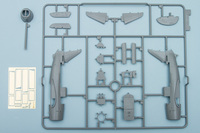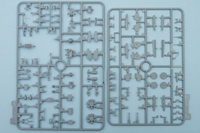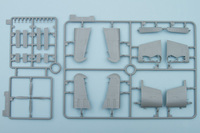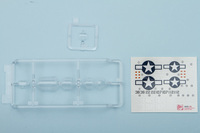
Cyber-Hobby 1/72 SB2C-3 Helldiver
By Chris Banyai-Riepl
Overview
The Curtiss SB2C Helldiver was designed to replace the SBD Dauntless in the US Navy as a dive bomber. Production did not go well, though, and the Navy would not accept any Helldivers until Curtiss made well over 800 changes to the design. It still was a faster aircraft than the Dauntless it replaced, and although it was not as well liked, it performed quite well in the remaining years of the Second World War.
The Kit
 When we saw the Cyberhobby 1/72 SB2C-4 Helldiver, many figured that we would see other Helldiver variants before long. Less than a year later, we have the first of other variants, the SB2C-3. The plastic is pretty much the same as that in the SB2C-4 kit, although there are several parts marked as not for use. There is a fret of photoetch included, and the decal sheet provides markings for three aircraft.
When we saw the Cyberhobby 1/72 SB2C-4 Helldiver, many figured that we would see other Helldiver variants before long. Less than a year later, we have the first of other variants, the SB2C-3. The plastic is pretty much the same as that in the SB2C-4 kit, although there are several parts marked as not for use. There is a fret of photoetch included, and the decal sheet provides markings for three aircraft.
 Construction starts with the fuselage innards, and the engine is a nice power egg assembly. There are both rows of cylinders, separate crankcase housing, and a separate exhaust ring on the back side. Painted up, this will look superb. For the cockpit, there's a lot of stuff going on here. First off, there's the option of having the rear deck open or closed, and both options are nicely done. There are separate radio racks, side consoles, control stick, a front seat with photoetch seat belts, a nicely done rear gun ring, and separate bulkheads. There's a lot to paint up here, and while there will undoubtedly be some aftermarket sets for this, out of the box this will look quite nice.
Construction starts with the fuselage innards, and the engine is a nice power egg assembly. There are both rows of cylinders, separate crankcase housing, and a separate exhaust ring on the back side. Painted up, this will look superb. For the cockpit, there's a lot of stuff going on here. First off, there's the option of having the rear deck open or closed, and both options are nicely done. There are separate radio racks, side consoles, control stick, a front seat with photoetch seat belts, a nicely done rear gun ring, and separate bulkheads. There's a lot to paint up here, and while there will undoubtedly be some aftermarket sets for this, out of the box this will look quite nice.
 With the inner bits together, the fuselage can go together, and the separate one-piece cowling covers up the engine. The rudder is separate, and the canopy comes in four main pieces (not counting the small clear part over the rear gun deck).With the fuselage together, the next step is the flying surfaces. The stabilizers feature separate elevators, and the wings have separate ailerons. These, combined with the separate rudder, will make painting these in slightly faded colors much simpler.
With the inner bits together, the fuselage can go together, and the separate one-piece cowling covers up the engine. The rudder is separate, and the canopy comes in four main pieces (not counting the small clear part over the rear gun deck).With the fuselage together, the next step is the flying surfaces. The stabilizers feature separate elevators, and the wings have separate ailerons. These, combined with the separate rudder, will make painting these in slightly faded colors much simpler.
Moving on to the wings, these have the option of being extended or folded. The folded option is well done, with good internal wing detail and sturdy connectors. The outboard wing sections also feature separate slats, and the dive brakes have photoetch covers to cover up the holes. The landing gear is sturdy, with separate retraction arms. When it's all over and done with, the finished model will look good sitting on those legs.
 For the decal schemes, all three are finished in the three-color camouflage of sea blue, intermediate blue, and white. The decal sheet is small, as the only markings found on these planes are small white numbers and tail markings. First up is White 107 from VB-7 off the USS Hancock CV-19 in 1944. This option also has a white horseshoe on the tail. The second option is also from VB-7 off the Hancock, and is just a number change to white 22. The final option is White 38 from VB-80 off the USS Ticonderoga CV-14 in 1944. The decals also include propeller labels.
For the decal schemes, all three are finished in the three-color camouflage of sea blue, intermediate blue, and white. The decal sheet is small, as the only markings found on these planes are small white numbers and tail markings. First up is White 107 from VB-7 off the USS Hancock CV-19 in 1944. This option also has a white horseshoe on the tail. The second option is also from VB-7 off the Hancock, and is just a number change to white 22. The final option is White 38 from VB-80 off the USS Ticonderoga CV-14 in 1944. The decals also include propeller labels.
Conclusion
This is a nice extension of the Cyberhobby Helldiver and opens up some more marking potential. Perhaps before the next year is out we'll see an SB2C-5 and maybe even an A-25 Shrike. My thanks to Dragon USA for the review sample.
